|
TRANSLATIONS
Today's morning paper, the cartoon page:
An ant-heap designed by an architect.
I could not have foreseen the appearance of this cartoon, yet it came exactly when I was going to begin writing about the kava glyph type:
 |
| kava |
It is a true synchronism, in contrast to such a false synchronisms as e.g. when I was writing about new year on December 31 - because I could have planned it so (even if I did not consciously do it).
|
A few preliminary
remarks and imaginations:
1. The
kava glyph type is like a crooked henua with sharp angles at the bends. It is as if the path of light had
rugged terrain to pass over. All over South America there is a
sign, the 'staircase' sign (Posnansky), which
appears in several different shapes and probably originated in
Tiahuanaco, where straight lines and right angles were
everywhere to be seen. Maybe this 'staircase' path of the sun is due
to the
geography with mountain ranges making it impossible for the sun rays
to illuminate all the earth below at once.
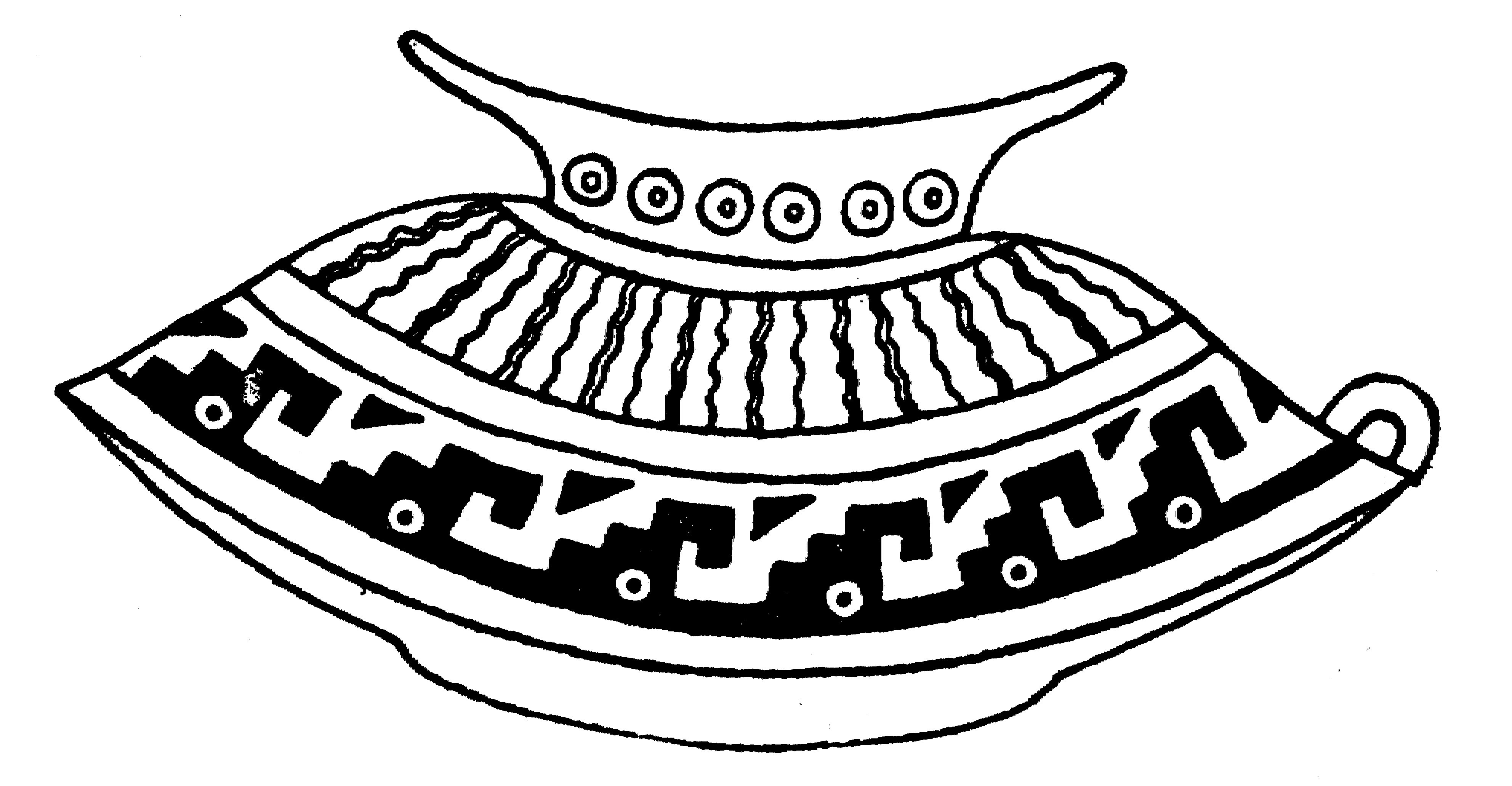
This piece of ceramics
(Posnansky) has the 'staircase' painted on it in black and white. As I interpret the design it is the earth receiving light, heat and water (wavy lines)
from the sun (6 double suns at the top). Our world in the sun is light
and the black world below (as in a mirror) has another 6 double suns.
There
is a black triangle above our steplike world in the light. In the 'black
mirror' we can see the black triangle reflected as a
white sun with black interior. When we are at winter solstice the
sun stands at its highest on the other side of the earth (in the
Otherworld as the Maya would say).
In Central America too we can see this
fundamental
play
of light and darkness. Famous is the snake undulating along the
northern staircase of the Pyramid of Kukulkan
(the feathered serpent) in Chichen Itza.
The
Egyptian picture below has the path of
the sun illustrated as a snake and the 4 heads are - according to Wilkinson
- the four sons of
Horus (the sungod). I suppose one interpretation is that they represent the four cardinal points
(or
maybe the four seasons):

|
|
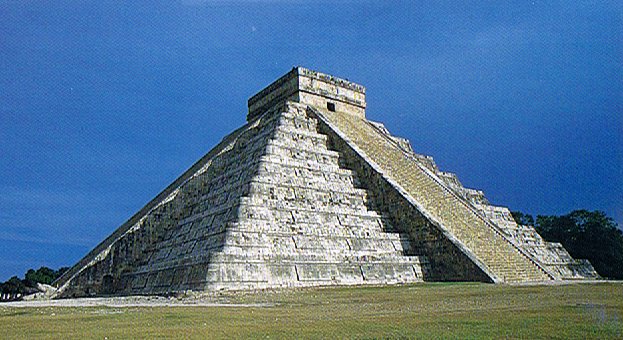
"Behind me, towering
almost 100 feet into the air, was a perfect ziggurat,
the Temple of Kukulkan.
Its four stairways had 91 steps each. Taken together with the top
platform, which counted as a further step, the total was 365. This
gave the number of complete days in a solar year. In addition, the
geometric design and orientation of the ancient structure had been
calibrated with Swiss-watch precision to achieve an objective as
dramatic as it was esoteric: on the spring and autumn equinoxes,
regular as clockwork, triangular patterns of light and shadow
combined to create the illusion of a giant serpent undulating on the
northern staircase." (Hancock)
Like
the path of the sun on the frieze on the Gateway of the Sun in
Tiahuanaco, meandering up and
down,
the Feathered Snake (Kukulkan, Quetzalcoatl etc) is the path of the
sun.
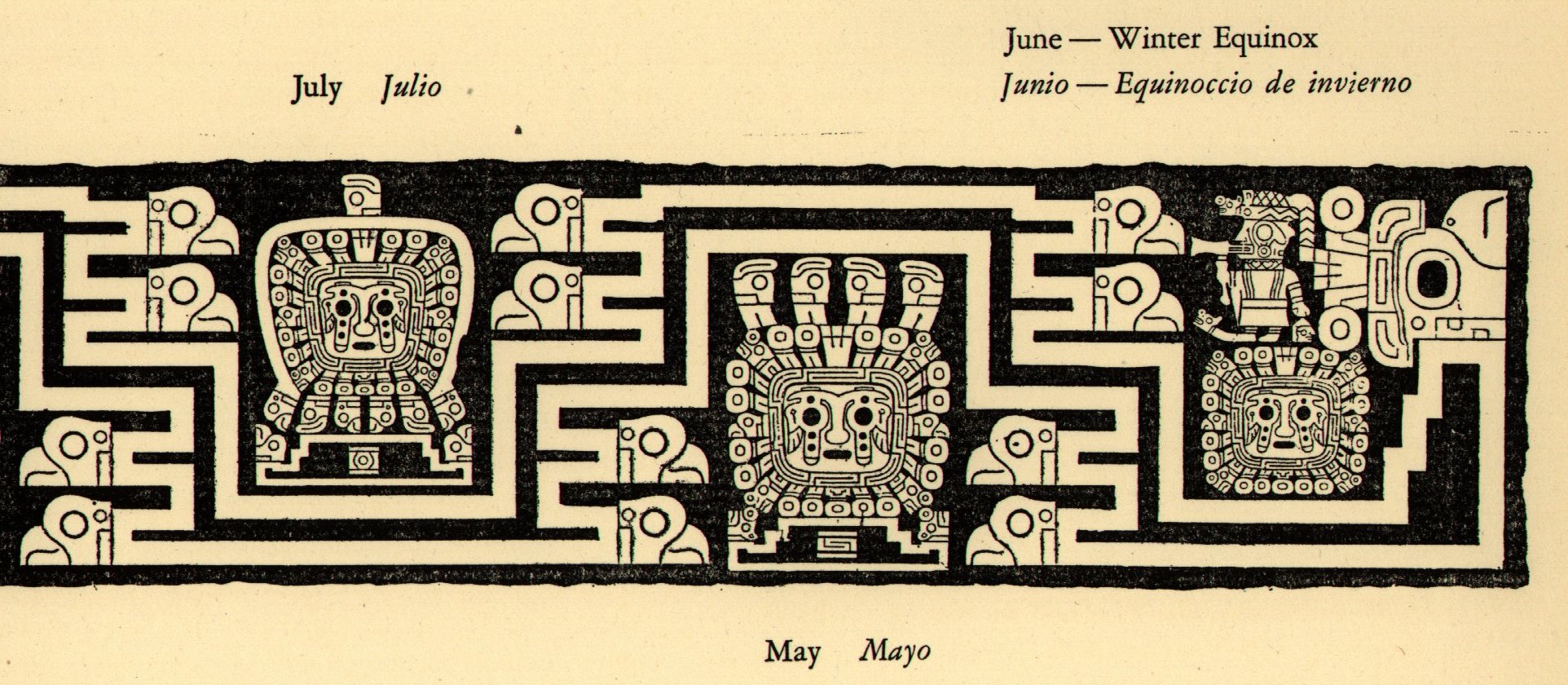
(Posnansky)
Feathers because the sun is flying high in the sky - it surely must
be a bird. But its
path undulates (as observed against the landmarks on the horizon) and therefore it must also be a snake.
|
The 4 sons of Horus have their heads located at the top of the undulations:

A human head is located at the top of a body, and if the man is standing up his head is pushed up as far as possible. Therefore tagata can be used to illustrate the high summer season. There is only one high summer season in a year, therefore the 4 sons of Horus could symbolize 4 years. The 5th year is a leap year, and time can be measured in groups of 4 + 1. If this concept was in the head of the artist, the snake head is the leap year, I guess.
|
2.
At the equinoxes light and darkness weigh even. Therefore
a
double rule
is in effect
at these cardinal points. In our minds we should
reflect on both. A paradox of Hui Shih (ca 3rd century B.C.) says: "The sun at noon is the
sun declining; the creature born is the creature dying." (Needham
II)
Churchill has pointed out that kavakava (rib) is related to
vakavaka:
"P Mgv.: vakavaka,
the breast. Mq.: vakavaka, vaŠvaŠ, rib. Ma.:
wakawaka, parallel ridges. We shall need all the
available material in order to determine the germ sense of this
word. Sa.: va'ava'a, the breast-bone of a bird; fa'ava'a,
the frame as of a slate. To.: vakavaka, the side. Fu.:
vakavaka, the side below the armpit. Ha.: hoowaa, to make
furrows.
In all these we may see
the idea of ridge or depression, or of both, as primal (Rapanui,
Samoa, Marquesas, Maori, Hawaii), and as secondary the part of the
body where such appearance is common (Mangareva, Tonga, Futuna)."
The front is (in) the light, the back is (in) the shadow. Equinox,
then,
must be (in) the side of the body.
On Easter Island a myth about moai kavakava was told which may contain
important clues.
|
|
"THE STORY OF THE WOODEN IMAGES
Tu'u Ko Ihu the priest and navigator, was the
tahunga who first carved images in this land. When he was living at
Ahu te peu this chief decided to go to the house at Hanga
Hahave called the House of Cockroaches. He therefore left in the early morning and climbed
up to Punapau. In front of the red cliff there he saw two
spirits, sleeping. They had no flesh, those spirits, their ribs were
showing. Their names were Hitirau and Nuku-the-Shark.
Tu'u ko ihu did not stop lest the spirits
whould know he had seen them. If they did he would die. He went on
his way toward the House of Cockroaches, but another spirit, Ha
uriuri, saw him, and he cried out to those others, 'Wake up! The
chief saw your ribs!' They woke up with a start and saw this human, they
saw his back as he walked up the mountain. Therefore they quickly
climbed and crossed the way in front of him. They asked him: 'What do you know?' Tu'u ko ihu answered,
'Nothing'. They said again, 'Perhaps you noticed something', but
Tu'u answered 'No.' The spirits disappeared.
Tu'u ko ihu went on his way, but the
spirits appeared in front of him again. They asked him, 'What do you
know about us, O ariki?' He answered still, 'I know nothing.' The chief went on, the spirits met him again at
Pukurautea. 'What do you know about us, O ariki?' 'Nothing.' If Tu'u ko ihu had told those
spirits he had seen them they would have killed him. His priestly
wisdom held him safe. They left, they disappeared. Afterwards they prowled about his house with their
hands up to their ears, listening to hear if he gossiped of what he
had seen; but the chief held his tongue. He spoke to no-one of what
he had seen.
When Tu'u ko ihu went down to the House of
Cockroaches the people were taking the stones from the earth-oven
and were throwing out the ends of burning wood. This wood was
toromiro. Tu'u ko ihu took two flaming pieces of wood
and carried them into that house, into Hare koka. He sat
there, and with his sharp pieces of obsidian he carved them into
moai kavakava.

They were like men who are dead, with their ribs
showing. They were likenesses of Hirirau and Nuku-the-Shark.
Tu'u ko ihu spoke to no person of what he had seen.
After he had made these male images Tu'u ko ihu
fell asleep and dreamed of two women. Their names were Pa'apa
ahiro and Pa'apa akirangi. In his dream he saw that they were hiding their
Things with their hands, they were covering them with their fingers;
therefore as soon as it was daylight he got up and carved two flat
images exactly like those women.
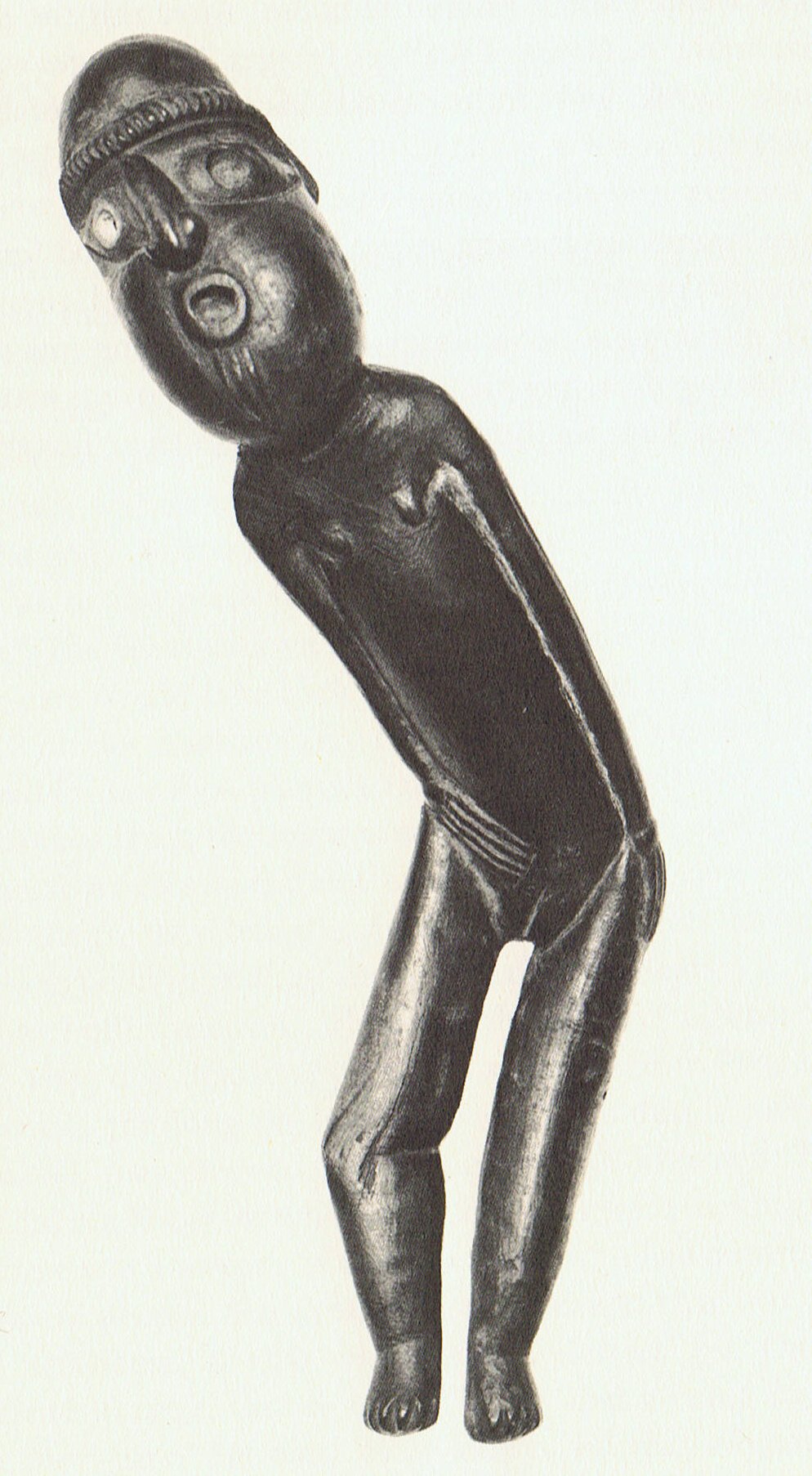
When he had finished, Tu'u ko ihu loaded
all the images on his back - the male images with ribs and the moai
paepae with their fingers in a certain place; and he returned to his
house at Ahu te peu. He left the moai standing in that house.
Tu'u ko ihu dwelt quietly in his house for
some time, and the people saw what he had done, they saw his work
with the wood. Then they all went to this chief with pieces of
toromiro to be carved. They wanted moai kavakava, they
wanted moai paepae. They lit their earth-ovens and cooked for
him many good things; seabirds, fish, yams and kumara. They
brought this good food to Tu'u ko ihu so that he would carve
images for them. The people got the moai
when they offered an umu to the owner. If there was no
earth-oven, he kept all those that he had made. He kept their pieces
of toromiro. One day all the men who had given wood but got
no images went to Tu'u ko ihu and said, 'O chief, give us
back our images.' 'You wait.' Then Tu'u ko ihu went into his
house and made all the images walk. They walked about inside the
house! After this the people called that house the House of Walking
Images. The images walked, they made turns and turns -
karari-karari, karari-karari, all about the house.
Their owners saw them doing this and said to one
another, 'See - these images are moving in the house! What good fun
this, the images that move!' They saw it, they were amazed, they
were filled with admiration. 'How funny are these walking images!'
In the evening those people who had made no ovens returned to their
houses. Tu'u ko ihu did not give them their images." (Legends
of the South Seas) |
Tu'u ko ihu was the name of the chief who stole the head of Hotu Matua from Ure Honu. He ran with it to Ahu Tepeu (where he once was living, cfr above):
|
A map shows Tepeu located on the western coast (close to the end of the kuhane journey):

Tuu Ko Ihu buried the head of the sun (god), i.e. he did exactly the opposite of hanging the skull high in his house. If we accept a view of the sacred geography where midsummer 'is equal to' Poike in the east, then a hole (meaning the lowest point) ought to be found in the west.
Tepeu surely is Te Peu and among the meanings of this word we find 'persons stooping with age', 'housebeams sagging under weight' ... When sun stands low in the sky his best time (midsummer) is past.
Another meaning in peu is 'to fold, to crease' - and our thoughts ought to go to the head of a ua club, where the compressed face causes wrinkles at the top. Instead of the long nose in the ao paddle (stretching the face so wrinkles disappear) the short nose is not enough to keep the sky vault high. Ihu means nose, and the creator of the story has given us a sign in the name of Tuu Ko Ihu ('the nose is standing') ... |
Hanga Hahave is located on the south coast:
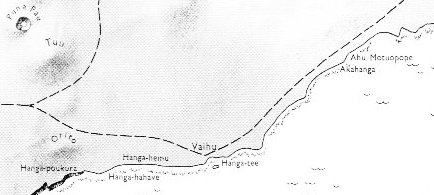
The Puna Pau moutain lies not far from there (top left in the map). The intention of Tu'u ko ihu probably was to go straight (as the bird flies) from Ahu Te Peu to Haga Hahave.
| Pau 1. To run out (food, water): eků pau te kai, te vai, is said when there is an abundance of food or water, and there is no fear of running out. Puna pau, a small natural well near the quarry where the 'hats' (pukao) were made; it was so called because only a little water could be drawn from it every day and it ran dry very soon. 2. Va'e pau, clubfoot. Paupau: Curved. Vanaga.
1. Hakapau, to pierce (cf. takapau, to thrust into). Pau.: pau, a cut, a wound, bruised, black and blue. 2. Resin. Mq.: epau, resin. Ta.: tepau, gum, pitch, resin. (Paupau) Hakapaupau, grimace, ironry, to grin. 3. Paura (powder), gunpowder. 4. Pau.: paupau, breathless. Ta.: paupau, id. 5. Ta.: pau, consumed, expended. Sa.: pau, to come to an end. Ma.: pau, finished. 6. Ta.: pau, to wet one another. Mq.: pau, to moisten. Churchill. |
Pau is 'finished':
| According to Manuscript E the explorers under Ira's leadership landed at Haga Te Pau at the beginning of the month He Maro (June, the winter solstice month on Easter Island). They began at once to construct a house and to plant yams.
"Hanga Te Pau lies halfway between the places Kioe Uri and Piringa Aniva, both of which are also designations for the month of June. In this sense, Hanga Te Pau occupies the correct position in the time-space scheme. Instead of turning to the right (facing the land) in their search for the residence of the king, the explorers turn in the opposite direction. From a chronological point of view, this turning to the left signifies a going back to the two winter months that have passed. Considering the condition in the new land, building a house on the rim of the crater and establishing a yam plantation are indeed suitable activities for the new settlers." (Barthel 2)
If ragi is a glyph type representing pillars for a house, then the house of the explorers is not the house which according to myth must be ready at summer solstice. There must be two houses, one at winter solstice and one at summer solstice (quite in order as there are two 'years' in a year). |
|
Winter solstice occurs in June and I have blackmarked the month with its two halves. The 'house' at summer solstice probably has Te Pou (Sirius) as a 'ragi pillar' erected already in July.
Notice the similarities between the names Te Pou and Te Pau (in Haga Te Pau) - as if mirror images of each other - one at the beginning and the other at the end of the year. Te Pau is located before winter solstice, while Te Pou comes after winter solstice. |
| 5. In the 'scheme of lunar nights', Hanga Te Pau introduces the second half of the month in contrast to Hanga Ohiro, which introduces the first half. That means that Vinapu and Anakena were calendary opposites. Based on the encoded information gained from numbers 1 and 2, 'Maro' (for the Vinapu area) is contrasted with 'Anakena' (for the Anakena area) - or, to put it differently, the last month of the year is contrasted with the first month of the year. |
|

|
Puna Pau means the source is 'out of water':
| Puna Water hole, well (natural or artificial). Vanaga.
Spring, fountain, well. P Pau.: mapunapuna, to bubble, to boil. Churchill. |
It is just an empty shell (paua).
Water and sun-light are twins. If the water is finished, then also the sun-light is finished. Twins die together.
Hanga Te Pau is of central importance in the sacred geography of Easter Island. Old fire can be fetched from there:
... He went out, and the third, Tuu Rano Kao, entered and kissed (his father). A Matua spoke: 'I wish you luck for your pebbles of Hanga Te Pau, for your (crater) Rano Kau!' That was all, and he went out ...
... After they had thrown the fish on the beach, Ira said, 'Make a fire and prepare the fish!' When he saw that there was no fire, Ira said, 'One of you go and bring the fire from Hanga Te Pau!' One of the young men went to the fire, took the fire and provisions (from the boat), turned around, and went back to Hanga Hoonu. When he arrived there, he sat down. They prepared the fish in the fire on the flat rocks, cooked them, and ate until they were completely satisfied. Then they gave the name 'The rock, where (the fish) were prepared in the fire with makoi (fruit of Thespesia populnea?) belongs to Ira' (Te Papa Tunu Makoi A Ira). They remained in Hanga Hoonu for five days ...
... When Tu'u ko ihu went down to the House of
Cockroaches the people were taking the stones from the earth-oven
and were throwing out the ends of burning wood. This wood was
toromiro. Tu'u ko ihu took two flaming pieces of wood
and carried them into that house, into Hare koka. He sat
there, and with his sharp pieces of obsidian he carved them into
moai kavakava ...
The two flaming pieces of toromiro became moai kavakava. I guess the spirits, Hitirau and Nuku-the-Shark, were the old twin half-years.
|










